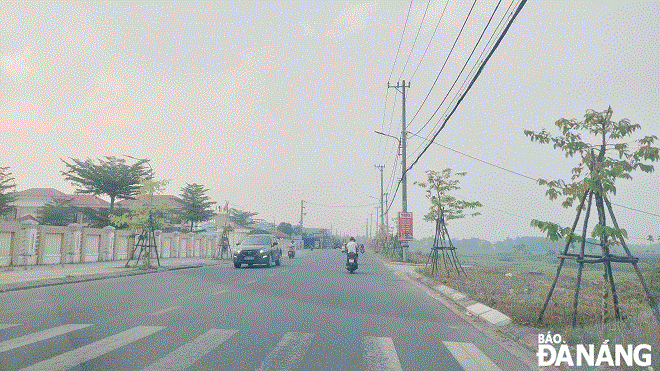Prioritizing transport infrastructure development to pave the way for Hoa Vang's growth
Transport infrastructure plays a vital role in promoting local socio-economic development. Therefore, Hoa Vang District is paying special attention to developing transport infrastructure in a synchronous and modern way in a bid to improve connections between communes to realize the district’s goal of turning it into a town by 2025.
 |
| DH2 route has been upgraded to make it more spacious and modern. Photo: TRONG HUNG |
Developing transport infrastructure in a synchronous manner
In its efforts to promote infrastructure development to boost economic growth, Hoa Vang District authority issued a decision on August 2, 2021, to deploy a project to upgrade transport infrastructure in a synchronous manner to meet new urban area criteria.
Mrs. Dinh Thi Thuy Huong, the Head of the District Economic and Infrastructure Office said that in recent years, Hoa Vang has witnessed positive changes in most fields, especially transport infrastructure development in a synchronous and modern way. In particular, concrete or asphalt inter-village and inter-commune roads, villages’ roads and hamlets’ roads, along with internal roads in residential areas have brought up a new aesthetically-appealing and modern facelift to Hoa Vang Suburban District. Important has been attached to deploying irrigation and infield infrastructure projects, thereby contributing to improving agricultural productivity. Furthermore, heed has been paid to upgrading schools, healthcare, and cultural facilities in villages and communes. Greater efforts have been made to decrease the number of temporary houses while special attention has been paid to building safe drinking water supply system.
Besides, 3 major national highways running through Hoa Vang include national highways 1A, 14B, 14G and La Son - Tuy Loan that provides convenient access to the district. The length of these national highways running through the district is 49km while that of provincial roads is 86 km, that of district roads is 54.4 km, that of inter-commune roads is 185 km, that of inter-village roads is 147 km, and that of alley roads is 478 km. The total length of Hoa Vang's inland waterways is 34.5km of rivers that include Cu De, Yen, Tuy Loan River, and Cau Do.
Currently, most of communal and village’s main concrete roads have width of 5.5m while some roads are asphalt. Meanwhile, concrete roads in residential areas have with of 2m-4m,.
“Over the past decade, with many mobilized resources, there are 892,695km of concrete or asphalt rural roads in the district. Currently, 8 communes of the district meet class-V urban standards in terms of transport infrastructure," added Mrs. Huong.
Mobilizing resources
Mr. Phan Van Ton, the Chairman of the Hoa Vang District People's Committee, said that since the implementation of the Resolution of the 17th District Party Congress in the 2020-2025 term, the district has poured around VND 1,949 billion into infrastructure development. Accordingly, the district has upgraded 73.2km of rural roads, 100.1km of street lighting, 31km of infield infrastructure, 53.2km of irrigation canals. Heed has been paid to upgrading 77 schools, 74 cultural works, 7 rural traditional markets, and more.
Furthermore, the District People's Committee has also asked for permission from the District People's Council to allocate capital for development projects in an attempt to help the district meet class-IV urban standards. Heed has been paid to asking for permission from municipal government to allocate capital for 17 projects in the district in the coming time.
According to Mr. Phan Van Ton, in its efforts to promote infrastructure development on a larger scale to realize the district’s goal of turning it into a town by 2025, the district will focus on creating master planning for communes, accelerating its planning practice for its new urban areas. Special attention will be paid to proactively coordinating with the city's project management boards to get their approval for zoning plan projects in the district to serve as a basis for deploying ongoing or under construction infrastructure projects. Important is attached to working with relevant local agencies to allocate capital for development projects to help the district meet class-IV urban standards. Heed is paid to accelerating site clearance for development projects, especially such key projects as the Hoa Lien - Tuy Loan expressway.
Reporting by TRONG HUNG – translating by H.L